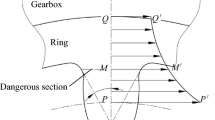Abstract
Case-carburizing enlarges the depth of the hardened layer at the tooth width end on the acute angle side of helical gears. For the helical gears with large helix angles (Exceeding 25°), this hardened layer may lower their bending fatigue strength. Therefore, we investigated the influence of this hardened layer on their bending fatigue strength through the bending fatigue tests. Our results suggest that this hardened layer might reduce the case-carburizing’s effect to enhance their bending fatigue strength. Thus, using only the maximum tooth root stress would be inadequate for evaluating their bending fatigue strength, and it would be necessary to consider the relationship between the hardened layer and the tooth root stress distribution (Especially, the stress applied at the tooth width end on the acute angle side) from the beginning of meshing to the end.
Similar content being viewed by others
References
JSME data book: Fatigue of metals (II), 2nd Ed., The Japan Society of Mechanical Engineers (1984) (In Japanese).
Q. Wang, Z. Li, H. Ma and B. Wen, Effects of different coupling models of a helical gear system on vibration characteristics, J. of Mechanical Science and Technology, 31 (5) (2017) 2143–2154.
M. Liu, C. Zhu, H. Liu and C. Wu, Parametric studies of lubrication performance of a helical gear pair with non-Newtonian fluids, J. of Mechanical Science and Technology, 30 (1) (2016) 317–326.
C. I. Park, Characteristics of noise generated by axial excitation of helical gears in shaft-bearing-plate system, J. of Mechanical Science and Technology, 29 (4) (2015) 1571–1579.
H. Jiang, Y. Shao, C. K. Mechefske and X. Chen, The influence of mesh misalignment on the dynamic characteristics of helical gears including sliding friction, J. of Mechanical Science and Technology, 29 (11) (2015) 4563–4573.
J. Wei, P. Gao, X. Hu, W. Sun and J. Zeng, Effects of dynamic transmission errors and vibration stability in helical gears, J. of Mechanical Science and Technology, 28 (6) (2014) 2253–2262.
J. Wei, W. Sun and L. Wang, Effects of flank deviation on load distributions for helical gear, J. of Mechanical Science and Technology, 25 (7) (2011) 1781–1789.
J. S. Kang and Y. S. Choi, Optimization of helix angle for helical gear system, J. of Mechanical Science and Technology, 22 (12) (2008) 2393–2402.
H. Zeyin, L. Tengjiao, L. Tianhong, D. Tao and H. Qiguo, Parametric modeling and contact analysis of helical gears with modifications, J. of Mechanical Science and Technology, 30 (11) (2016) 4859–4867.
X. Wang, Y. Wang, X. Zhao and X. Li, Study on superharmonic resonance for gear transmission based on teeth surface friction, J. of Mechanical Science and Technology, 29 (11) (2015) 4631–4638.
H. Zhai, C. Zhu, C. Song, H. Liu, G. Li and F. Ma, Dynamic modeling and analysis for transmission system of high-power wind turbine gearbox, J. of Mechanical Science and Technology, 29 (10) (2015) 4073–4082.
W. Sun, X. Li, J. Wei, A. Zhang, X. Ding and X. Hu, A study on load-sharing structure of multi-stage planetary transmission system, J. of Mechanical Science and Technology, 29 (4) (2015) 1501–1511.
D. Jelaska, Gears and gear drives, Wiley (2012).
S. P. Radzevich, Dudley's handbook of practical gear design and manufacture, 2nd Ed., CRC Press (2012).
F. L. Litvin and A. Fuentes, Gear geometry and applied theory, 2nd Ed., Cambridge University Press (2004).
C. Naruse, Haguruma no kiso to sekkei (Fundamentals and design of gears), Yokendo (1994) (In Japanese).
ISO 6336-3: Calculation of load capacity of spur and helical gears–Part 3: Calculation of tooth bending strength, 2nd ed., Corrected version, International Organization for Standardization (2007).
K. Nojima and T. Koide, Root stress analysis of the large helix angle helical gears, Proc. of the Japan Society for Design Engineering 2015 Autumn Meeting, Sapporo, Japan (2015) 59–62 (In Japanese).
T. Aida, S. Oda, K. Kusano and Y. Ito, Bending fatigue strength of case-hardened gears, Bulletin of JSME, 11 (44) (1968) 336–343.
JIS G 4053, Low-alloyed steels for machine structural use, Japanese Industrial Standards Committee (2016), <http://www.jisc.go.jp/app/jis/general/GnrJISSearch.html> (Accessed 31 May 2017) (In Japanese).
JIS B 1702-1, Cylindrical gears - ISO system of flank tolerance classification - part 1: definitions and allowable values of deviations relevant to flanks of gear teeth, Japanese Industrial Standards Committee (2016), <http://www.jisc.go. jp/app/jis/general/GnrJISSearch.html> (Accessed 31 May 2017) (In Japanese).
K. Kawata, Hontōni yoku wakaru chikka shintan purazuma CVD: kō kinō hyōmen kaishitsu-hō no kiso to ōyō (True understanding of nitriding, carburizing and plasma-CVD: Fundamental and application of advanced surface modification method), Nikkan Kogyo Shinbun, Ltd. (2012) (In Japanese).
Netsushori sōsubukku dai 1-kan: Shintan oyobi shintan chikkashori (Heat treatment source book, volume 1: Carburizing and carbonitriding treatment), Japan Society for Heat Treatment (2008) (In Japanese).
H. Fujio, T. Aida and J. Akizono, Distortions and residual stresses of gears caused by hardening: 4th report, Casehardening of gears, Bulletin of JSME, 22 (169) (1979) 1009–1016.
S. Oda and Y. Shimatomi, Study on bending fatigue strength of helical gears: 1st report, effect of helix angle on bending fatigue strength, Bulletin of JSME, 23 (177) (1980) 453–460.
<http://www.solidworks.com/sw/products/simulation/packages.htm> (Accessed 31 May 2017).
A. Kubo and K. Umezawa, On the power transmitting characteristics of helical gears with manufacturing and alignment errors: 1st report, fundamental consideration, Transactions of the Japan Society of Mechanical Engineers, 43 (371) (1977) 2771–2783 (In Japanese).
W. Xue, Study on residual stress and bending fatigue strength of case-hardened thin-rimmed gears, Ph.D. Thesis, Tottori University (2004) <http://repository.lib.tottori-u.ac.jp/Repository/metadata/2624> (Accessed 31 May 2017) (In Japanese).
Author information
Authors and Affiliations
Corresponding author
Additional information
Kengo Nojima received his B.S. in Mechanical Engineering from Tottori University in 2002. Since 2003, he has been working in Tottori Institute of Industrial Technology and his current position is the Assistant Research Engineer. He is also a Ph.D. student at Tottori University. His research interests include mechanical element parts and metallic materials.
Rights and permissions
About this article
Cite this article
Nojima, K., Ogata, K., Tanaka, M. et al. Bending fatigue strength of case-carburized helical gears (In the case of large helix angles). J Mech Sci Technol 31, 5657–5663 (2017). https://doi.org/10.1007/s12206-017-1106-0
Received:
Revised:
Accepted:
Published:
Issue Date:
DOI: https://doi.org/10.1007/s12206-017-1106-0



